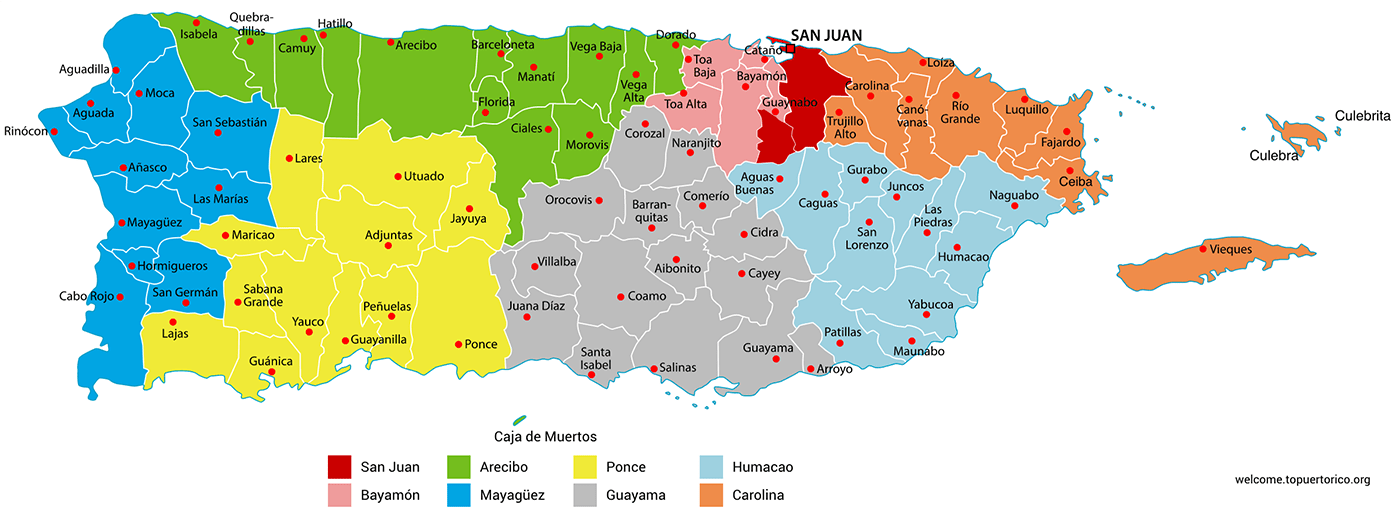Puerto Rico's Electoral Districts
Puerto Rico's senatorial districts refers to the electoral districts in which Puerto Rico is divided for the purpose of electing 16 of the 27 members of the Senate of Puerto Rico.
Section 3 of Article III of the Constitution of the Commonwealth of Puerto Rico provides that Puerto Rico shall be divided into eight senatorial districts and forty representative districts. Each senatorial district shall elect two Senators and each representative district one Representative.
In addition, Section 4 of Article III, provides that the division into senatorial and representative districts shall be reviewed after each ten-year census beginning in 1960, by a Board composed of the Chief Justice of the Supreme Court as Chairman and of two additional members appointed by the Governor with the advice and consent of the Senate. The two additional members shall not belong to the same political party.
The island is currently divided in eight senatorial districts and forty representative districts, each based on a similar number of inhabitants. Adopted on June 3, 2011 by the sixth Constitutional Review Board of the Senate and Representative Districts, composed of Federico Hernandez Denton, Chief Justice of the Supreme Court, as his President, and by Virgilio Ramos Gonzalez and Hector Luis Acevedo, as additional members.
The new distribution made the following updates: (changes made to June 3, 2011)
- The municipality of Guaynabo was divided between the senatorial districts of San Juan and Bayamon the neighborhoods Frailes and Pueblo Viejo, and part of the Pueblo district remained in the senatorial district of Bayamon, while the rest of the municipality became part of the senatorial district of San Juan.
- The municipality of Toa Alta passed from the senatorial district of Arecibo to the senatorial district of Bayamon.
- The municipality of Morovis passed from the senatorial district of Guayama to the senatorial district of Arecibo.
- The municipality of Arroyo passed from the senatorial district of Humacao to the senatorial district of Guayama.
San Juan
- San Juan
- Guaynabo (except: Frailes, Pueblo (partial), and Pueblo Viejo)
Bayamón
- Bayamón
- Cataño (parts: Frailes, Pueblo (partial) and Pueblo Viejo)
- Guaynabo
- Toa Alta
- Toa Baja
Arecibo
- Arecibo
- Barceloneta
- Camuy
- Ciales
- Dorado
- Florida
- Hatillo
- Manatí
- Morovis
- Quebradillas
- Vega Alta
- Vega Baja
Mayagüez
- Aguada
- Aguadilla
- Añasco
- Cabo Rojo
- Hormigueros
- Isabela
- Las Marias
- Mayagüez
- Moca
- Rincón
- San Germán
- San Sebastián
Ponce
- Adjuntas
- Guánica
- Guayanilla
- Jayuya
- Lajas
- Lares
- Maricao
- Peñuelas
- Ponce
- Sabana Grande
- Utuado
- Yauco
Guayama
- Aibonito
- Arroyo
- Barranquitas
- Cayey
- Cidra
- Coamo
- Comerío
- Corozal
- Guayama
- Juana Díaz
- Naranjito
- Orocovis
- Salinas
- Santa Isabel
- Villalba
Humacao
- Aguas Buenas
- Caguas
- Gurabo
- Humacao
- Juncos
- Las Piedras
- Maunabo
- Naguabo
- Patillas
- San Lorenzo
- Yabucoa
Carolina
- Canóvanas
- Carolina
- Ceiba
- Culebra
- Fajardo
- Loíza
- Luquillo
- Río Grande
- Trujillo Alto
- Vieques




